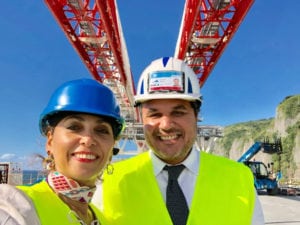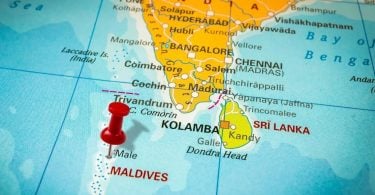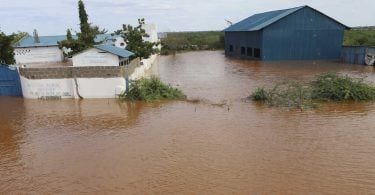The New Coastal Road (NCR) on Reunion Island will be a welcome relief to thousands of local motorists who, for years, have had to endure the threat of falling rocks and multiple closures due to severe weather – the old road is impassable on average around 40 times a year
The new road will be situated at a distance from the volcanic isle on huge columns rising out of the Indian Ocean, which will avoid dangerous rock falls. The €1.6bn project has been billed as the most expensive road (per kilometre) in the world. It was back in 2013, when the Regional Council started construction on the 12.5km road after 20 years of public debates, studies, enquiries around the need for a new infrastructure. Pressure mounted substantially on the authorities to take action after a major rock fall cost the lives of two Reunion Island road users in 24 March, 2006. The road, which will provide a safer link between St Denis, the largest city and La Possession; the island’s other big city, and the main port, Port des Galets. It is being built by a consortium of French companies including Vinci Construction Grands Projets, Bouygues Travaux Publics, Dodin Campenon Bernard and Demathieu Bard Construction. The first section will be opening this year with the remaining section planned for completion in 2020. New viaduct The most eye-catching part of the project is the 5.4km viaduct built along the coastline from Saint-Denis to La Grande Chaloupe. It will be able to withstand 90mph hurricane winds and waves of up to 10 metres. The major difference with the new road compared with the current coastal route (RN1) is that it will have three lanes in either direction including two integrated bus lanes and provision for cyclists and pedestrians. It is expected to play a major role in the economic revival of the island, especially in the tourism and construction industries.
Building the viaduct
The viaduct will have 48 bridge piers and a supporting structure comprising 1,386 precast segments. The bridge piers, weighing 4,800 tons, are prefabricated at the first production site at Port Est and then transported and installed on-site using the world’s largest offshore overhead travel crane, manufactured by Enerpac, that is mounted on ‘Zourite’ – a 107-metre long and 44-metre wide barge. The barge is being powered by four Cat 3508 marine engines and is equipped with a concrete mixer, built specifically for the project. The second production site is in the Rear Port Zone for the prefabrication of the voussoirs – the arch-shaped sections used in the building of a viaduct – for the deck. The prefabrication method of construction for the structure ensures a maximum amount of work is carried out in optimal conditions of work and safety and “minimises operations at sea, which can be very constraining, notably with respect to meteorological conditions. The possibility of working or not depends on predetermined criteria such as wave height, wind speed, type of activity and equipment used”, stated the report Laying the Coastal Viaduct Bridge Piers at Sea.
Caterpillar
Cat dealer SCIMAT supplied equipment and services for the whole length of the 12.5km project. The 6015B is a 140 tonnes hydraulic shovel, more commonly found in mining applications has been working under the water line, laying material. Its boom/stick is 34 m long and this machine can only be shipped in parts. his model was launched at bauma Conexpo Africa 2016. The Cat 336F excavator, the 740 articulated truck, the D8 dozer and the 988H wheel loader have been involved with the earthmoving part of the project. The two 390F excavators have been digging up to 25 metres under the sea, creating a solid foundation to place the viaduct supports. Neal Markham, strategy manager at Caterpillar, “With a project as important as this one on Reunion Island it is certain that the contractors involved, and everyone who uses the new road thereafter, want to know that it has been built with quality. Quality to withstand the frequent rain storms and sea activity, quality to last and quality to make sure that safety remains paramount. The provision of Cat machines and our dealer SCIMAT’s vast experience shows that quality is certainly a major focus of this project. “In difficult construction scenarios such as digging underwater (where one cannot see the bucket), or loading heaving materials into sensitive areas, one needs a machine which can perform, is reliable and efficient. Caterpillar engineers have invested significant time and money into R&D to make sure we can offer machines to match such construction activities. We are proud to be a part of this iconic project and continue to support both the dealer and customer in making sure they are going to meet their overall deadlines.”
Update on works
The Grande Chaloupe Viaduct was delivered and inaugurated on 6 September, 2017. Sea and land works are continuing on the Viaduct du Littoral. The voussoirs for the decks, weighing up to 670 tons are being transported by high-capacity multi-wheeled trolleys, known as fardiers and put in place by Zourite the mega-barge, while other elements are transported to the launcher station, which is a large beam at Port Est.
Construction works planned in 2018
• The construction of the upper part of the Saint-Denis dyke continues and the lower part of the south dyke section from the Grande Chaloupe will be completed
• The continuation of the construction of the supports and the deck of the Viaduc du Littoral
• The continuation of the upper dykes D1 and D3; and the start of the lower dykes D4 and D5
• The contract award for paving at the end of 2018
• The contract award to build the Saint-Denis interchange in February 2018 and to start work in the second half of 2018
• Construction of the dykes continues: completion of the construction of the lower part and upper part of the Saint-Denis dyke and completion of the lower part of the south dyke section from the Grande Chaloupe

























